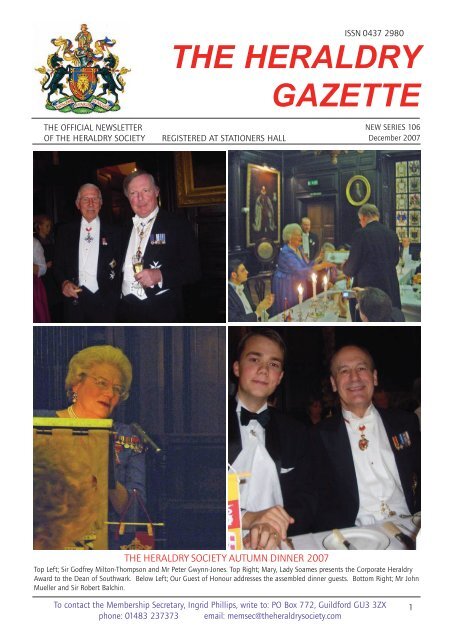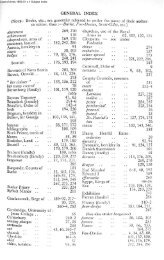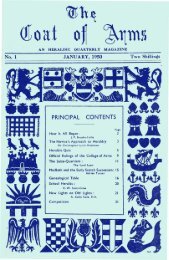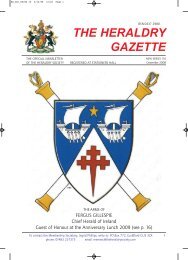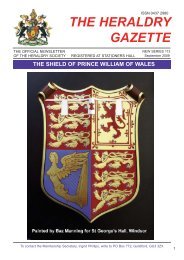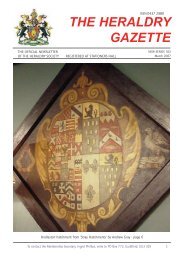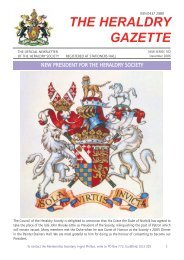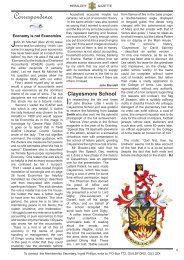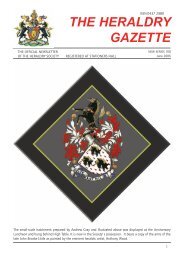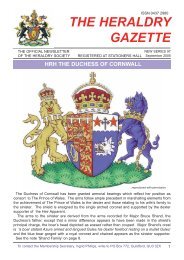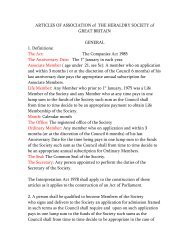You also want an ePaper? Increase the reach of your titles
YUMPU automatically turns print PDFs into web optimized ePapers that Google loves.
THE OFFICIAL NEWSLETTER<br />
OF THE HERALDRY SOCIETY REGISTERED AT STATIONERS HALL<br />
ISSN 0437 2980<br />
THE HERALDRY<br />
GAZETTE<br />
To contact the Membership Secretary, Ingrid Phillips, write to: PO Box 772, Guildford GU3 3ZX<br />
phone: 01483 237373 email: memsec@theheraldrysociety.com<br />
NEW SERIES 1<strong>06</strong><br />
December 2007<br />
THE HERALDRY SOCIETY AUTUMN DINNER 2007<br />
Top Left; Sir Godfrey Milton-Thompson and Mr Peter Gwynn-Jones. Top Right; Mary, Lady Soames presents the Corporate <strong>Heraldry</strong><br />
Award to the Dean of Southwark. Below Left; Our Guest of Honour addresses the assembled dinner guests. Bottom Right; Mr John<br />
Mueller and Sir Robert Balchin.<br />
1
2<br />
THE SOCIETY’S<br />
AUTUMN DINNER<br />
by John Tunesi of Liongam<br />
It was a late autumnal evening when on<br />
Wednesday, 14th November some 71 members and<br />
their guests foregathered within the magnificent<br />
Apothecaries’ Hall in the City of London.<br />
As usual, the evening was one of conviviality and<br />
good fellowship. We were honoured to have as our<br />
guest of honour for the evening, Mary, Lady Soames,<br />
LG, DBE, daughter of that great parliamentarian, Sir<br />
Winston Spencer Churchill and widow of the diplomat<br />
Sir Christopher Soames, the last Governor of Rhodesia.<br />
In his introduction to Lady Soames, our Chairman,<br />
David White, Somerset Herald spoke of the<br />
indiscretion of his erstwhile colleagues at the College<br />
of Arms in foisting on Lady Soames’ ancestors, the<br />
Spencers, a wholly bogus connection with the<br />
mediaeval family of Despencer in order to concoct for<br />
the newly risen family of Spencer a more perceivably<br />
ancient lineage. Lady Soames in responding to the<br />
health of the <strong>Society</strong> gave one or two anecdotes<br />
regarding her late father that were well received by<br />
the company.<br />
During the course of the evening, Lady Soames<br />
presented the <strong>Society</strong>’s Corporate <strong>Heraldry</strong> Award for<br />
2007 to Dean Colin Slee, Dean of Southwark on<br />
behalf of Southwark Cathedral. This year’s award was<br />
made to the cathedral for its creative use of its<br />
recently granted arms in and about the environs of the<br />
cathedral. In receiving the award, a splendid example<br />
of the herald painter and scrivener’s work, the Dean<br />
gave a totally impromptu rationale behind the<br />
granting of the cathedral’s new armorial bearings<br />
interspersed with a good deal of humour that was<br />
greatly appreciated by those present.<br />
On driving home to North Hertfordshire, my wife<br />
and I were, as you do, set to discuss how the evening<br />
went, and we were of the opinion that the evening<br />
was a great success. For those of you who have never<br />
attended one of <strong>Society</strong>’s biennial dinners, I think you<br />
would be best advised to try to come to next such<br />
dinner that is due to be held in 2009. You will find it<br />
a great pleasure to attend!<br />
ABOVE <strong>The</strong> full achievement of arms of Mary, Lady<br />
Soames as d<strong>ep</strong>icted by Dr Jiří Louda. Dr Louda has<br />
painted the achievements of all of the Knights and<br />
Ladies of the Garter from 1348 to the present day,<br />
thus producing an Armorial of the Order.<br />
BELOW When an appointment is made to the Order<br />
of the Garter, a shield, or a lozenge in the case of a<br />
Lady, is placed in St George’s Hall at Windsor Castle<br />
on which is d<strong>ep</strong>icted the arms of the Companion.<br />
Below is the Lozenge created for Mary, Lady Soames<br />
by Baz Manning. It d<strong>ep</strong>icts the arms of Christopher,<br />
Lord Soames impaling the perhaps better known<br />
arms of Churchill.<br />
R<strong>ep</strong>roduced with the kind permission of the Royal Household,<br />
Windsor Castle.<br />
Items for inclusion in the Gazette post to: <strong>The</strong> Editor, <strong>The</strong> <strong>Heraldry</strong> Gazette, at the address given on<br />
page 14, or e-mail to: heraldry.gazette@mac.com
GREATER MANCHESTER<br />
STUDY DAY 2007<br />
<strong>The</strong> 13th Study Day was<br />
held in Salford on October<br />
12th and was a great<br />
success with over thirty<br />
attenders from various<br />
heraldry societies. It was<br />
particularly gratifying to<br />
welcome the Secretary of<br />
the <strong>Heraldry</strong> <strong>Society</strong>, Melvyn<br />
Jeremiah and the Treasurer<br />
of the Scots <strong>Society</strong>, Stuart<br />
Emerson. <strong>The</strong> speakers<br />
covered a variety of topics<br />
and all were well received.<br />
<strong>The</strong> venue and the services<br />
provided were of the highest<br />
order and there were lots of<br />
positive comments and two<br />
attenders have become members of the society which is always encouraging. This success always d<strong>ep</strong>ends upon<br />
the hard work of the organisers and thanks are due to Alan Fennely (whose sixth conference this was) and Barry<br />
Wilde (making his organising debut). We particularly thank the <strong>Heraldry</strong> <strong>Society</strong> for their generous grant which<br />
makes this (now annual) event possible. <strong>The</strong> photograph shows the Secretary, Melvyn Jeremiah, with organizers<br />
Alan Fennely (left) and Barry White (right). With them is St<strong>ep</strong>hen Slater.<br />
STANDARD of CLIVE ALEXANDER<br />
Commissioned and recently executed in fine needlework by Margaret French who trained at the<br />
Royal College of Needlework where she was commended for teaching young embroiderers.<br />
Margaret specialises in Regimental, Masonic, Ecclesiastical, Commemorative and Celebratory work.<br />
<strong>The</strong> arms in the hoist are Blazoned Per Pale Argent and Sable. in Chief two Strakes of the<br />
Worshipful Company of Pewterers in Base a Rose all Counter Changed. <strong>The</strong> Badge a Strake Or<br />
charged with a Fleur de Lys bendwise, per bend Argent and Sable. Motto. Vires in Scientia,<br />
Strength in Knowledge. Granted by <strong>The</strong> College of Arms 2004,<br />
Items for inclusion in the Gazette: post to the Editor, <strong>The</strong> <strong>Heraldry</strong> Gazette, at the address given on<br />
page 14 or by e-mail to heraldry.gazette@mac.com<br />
3
4<br />
BARCLAYS<br />
EAGLE<br />
by Martin Davies<br />
One of Britain’s largest heraldic<br />
devices (right) has been removed<br />
from the Barclays building in Poole,<br />
Dorset. Barclays has denied it<br />
removed the eagle because of<br />
concerns that it has possible Nazi<br />
connotations. Some national<br />
newspapers said the bank - at that<br />
time trying to buy Netherlands<br />
group ABN Amro - "feared its eagle<br />
might offend Dutch customers".<br />
Barclays said it removed the sign<br />
because it is moving to new offices.<br />
<strong>The</strong> leader of Poole council, Brian Leverett said: "One<br />
is always sorry when you see a familiar landmark go<br />
from the area. One could almost see it as a piece of<br />
local art. It is a decision tinged with sadness."<br />
Resident Amanda Steele, 45, said: "I'm really sad<br />
that the eagle has been taken down as it has been<br />
watching over the town for so long. I have grown quite<br />
attached to it over the years. Lots of people work in the<br />
building and so it has become very important in the<br />
town and the eagle is a part of it."<br />
A spokesman for the bank said: “<strong>The</strong> logo has been<br />
taken down purely because it is a very old version of<br />
our eagle. We are moving out of the building, which<br />
is a back office, in stages to another site by 2010. Our<br />
corporate logo is Barclays and the eagle. If we were to<br />
merge - and this is by no means certain - it would be<br />
known as Barclays, with the shield of ABN Amro. We<br />
will continue to use the eagle in UK branches”.<br />
<strong>The</strong> Spread Eagle emblem has featured prominently<br />
throughout the history of Barclays. In the late<br />
seventeenth century a goldsmith-banker called John<br />
Freame was living in the City of London. <strong>The</strong> exact<br />
date he started his business is not known, but in 1690<br />
he was a partner in a banking business which traded<br />
at premises in Lombard Street. In those days very few<br />
people could read and write and business houses used<br />
pictorial signs so that their customers could find them<br />
easily. <strong>The</strong> use of street signs to identify buildings goes<br />
back to a decision of the Corporation of London in<br />
1580 which ordered “that shopke<strong>ep</strong>ers shall hang out<br />
signs at theire shopps”<br />
In 1728 the partnership moved to 54 Lombard<br />
Street at the sign of the Black Spread Eagle, and in<br />
1736 Freame's son Jos<strong>ep</strong>h took on his brother-in-law<br />
James Barclay as a partner. <strong>The</strong> business expanded<br />
over the years and other properties in Lombard Street<br />
were acquired, many with their own signs, but the<br />
Spread Eagle was to remain associated with the<br />
Barclay partnership.<br />
In the 1930s Barclays Bank Limited sought and<br />
obtained a Grant of Arms (above). <strong>The</strong> Bank naturally<br />
wanted to ke<strong>ep</strong> the Eagle it had used for so long but,<br />
because other ancient and royal houses carried it in<br />
various forms, the College of Arms ruled that it must<br />
be “differenced”. This was done appropriately by<br />
adding three silver crowns (since numbers 43 and 55,<br />
Visit the website at www.theheraldrysociety.com
oth part of the Head Office site, bore the<br />
signs of the Three Crowns and the Three<br />
Kings), and the Grant of Arms was<br />
accordingly made in 1937. <strong>The</strong><br />
College of Arms having said that they<br />
had no objection, a Board Resolution<br />
in 1947 authorised the closely<br />
associated Barclays Bank (Dominion,<br />
Colonial and Overseas) to use the arms,<br />
with the addition of “D.C.O.” In practice,<br />
this addition was usually placed on a scroll<br />
beneath the shield, as if it were a motto.<br />
As Barclays grew and expanded over the years,<br />
many different versions of the Eagle appeared, so in<br />
August 1981 a woodcut design by the celebrated<br />
engraver Reynolds Stone was adapted and simplified<br />
by John York to produce one authorised version for the<br />
whole of the Barclays Group.<br />
In 1999 design agency Interbrand<br />
Newell and Sorrell were briefed to<br />
update the Barclays brand including<br />
the eagle. <strong>The</strong> new design had to be<br />
warm, open and highly accessible but<br />
reflecting the stature and heritage of a<br />
world respected bank. <strong>The</strong> ‘eagle globe’<br />
(left), designed to be less imposing and<br />
aggressive than the heraldic version, took<br />
Barclays into the new millennium. However, the<br />
design proved technically difficult to r<strong>ep</strong>roduce on<br />
paper, so in 2004 the brand was refreshed and a new<br />
visual identity created incorporating a simpler style of<br />
eagle and standardising the 'Barclay blue' (below).<br />
E-mail the editor at heraldry.gazette@mac.com 5
6<br />
Rev Canon ANDREW<br />
by Jorge Rivera<br />
My great friend, <strong>The</strong> Reverend Canon John G. B.<br />
Andrew, OBE DD, Rector Emeritus of Saint Thomas<br />
Church Fifth Avenue in New York City, celebrated his<br />
50th anniversary as a priest this summer. As a special<br />
gift, I asked Marco Foppoli if he would be willing to fit<br />
a rendering of Canon Andrew’s arms into his (I am sure<br />
very busy) summer schedule. Thankfully, he acc<strong>ep</strong>ted<br />
the commission. Below is his rough sketch and to the<br />
right the final rendering. <strong>The</strong> scan, of course, does not<br />
do the actual piece a bit of justice. His highlighting<br />
and gold work make the piece appear to float on the<br />
paper!<br />
Taking some creative/interpretive licence with<br />
Marco’s reasoning for the layout of the composition (I<br />
wish my Italian was half as good as his English), here<br />
is what he said:<br />
“I think this oval shield is very good for the<br />
composition. I like the joints (offered by placing the<br />
shield over the cross.) (I also like) the bi-dimensional<br />
sense (offered by the positioning play between the<br />
cords, the tassels and the cross). <strong>The</strong> round high part<br />
of the shield is very useful for this (use) of joint, and<br />
(the space offered) below its strong curve (provides for<br />
better display) of (the) tassels and better show of the<br />
ribbons.”<br />
E-mail the editor at heraldry.gazette@mac.com<br />
Thank you to Marco for a wonderful piece! Canon<br />
Andrew loved it!<br />
Canon Andrew and Jorge Rivera at the rec<strong>ep</strong>tion in<br />
honour of Lord Lyon King of Arms Robin Orr Blair CVO<br />
WS, where Lord Lyon received the New York<br />
Genealogical and Biographical <strong>Society</strong>’s Medal for<br />
Heraldic Achievement on 5 March 2007 in New York<br />
City. <strong>The</strong> black-tie gala was organized with the<br />
participation of members of the board of the College<br />
of Arms Foundation. What a great event!
Archbishop Emeritus<br />
MAURICE COUVE de MURVILLE<br />
A Christmas gift<br />
suggestion<br />
A HUMOROUS GUIDE TO<br />
HERALDRY by Jack<br />
Carlson. £9<br />
ISBN 0-9766108-0-9<br />
A book on heraldry<br />
written by a teenager for<br />
teenagers but which will<br />
appeal to anyone with a<br />
sense of humour<br />
whatever their age!<br />
Copies can be ordered through the <strong>Heraldry</strong> <strong>Society</strong><br />
Bookstall.<br />
We were saddened to hear of the death of one of<br />
our Vice Presidents, the Most Reverend Maurice Couve<br />
de Murville, Archbishop Emeritus of Birmingham, He<br />
died on 3 November at St. Jos<strong>ep</strong>h ‘s Convent,<br />
Littlehampton. A Requiem Mass was held at Arundel<br />
Cathedral on Friday 16 November in the presence of<br />
His Grace <strong>The</strong> Duke of Norfolk, the <strong>Society</strong>’s President.<br />
<strong>The</strong> <strong>Society</strong> was r<strong>ep</strong>resented by the Chairman, David<br />
White. <strong>The</strong> Archbishop had returned to Sussex on his<br />
retirement from Birmingham in 1999, much of his<br />
earlier career having been spent as a Sussex parish<br />
priest and Chaplain to Sussex University. . At the<br />
Rec<strong>ep</strong>tion of the Body at the Cathedral his coffin was<br />
covered with a white pall by four of the Franciscan<br />
Sisters of Littlehampton who had looked after him in<br />
his final illness. Further ceremonies took place later at<br />
St. Chad’s Cathedral, Birmingham with a Requiem<br />
Mass being held there on 21 November followed by<br />
interment at St. Mary’s College, Oscott.<br />
Visit the website at www.theheraldrysociety.com 7
8<br />
AN EXCHANGE OF LETTERS<br />
After the Birmingham International <strong>Heraldry</strong> Conference this year, the following<br />
letters were exchanged between Mr Ralph Brocklebank and Garter Principal King<br />
of Arms, Mr Peter Gwynn-Jones. Both correspondents were keen to share their<br />
thoughts with readers of the <strong>Heraldry</strong> Gazette and the editor hopes that they will<br />
inspire some lively and interesting debate through this publication’s<br />
correspondence columns.<br />
From Ralph Brocklebank to Garter King of Arms:<br />
<strong>The</strong> Birmingham International <strong>Heraldry</strong> Conference<br />
held earlier this month was rated a great success by<br />
those who attended, and finished with a debate on the<br />
Future of <strong>Heraldry</strong>. I thought you might be interested<br />
to hear some of the concerns and points that were<br />
discussed.<br />
It was generally felt that if heraldry is to have a<br />
prosperous and flourishing future, it needs to take<br />
greater account of changes in society, such as the<br />
increasing emancipation of women and the<br />
disappearance of class barriers. <strong>The</strong>re is a large<br />
number of worthy people who have a nascent interest<br />
in heraldry as something belonging to our English<br />
heritage, but are given to believe that it is only for the<br />
rich and famous, or else of purely historic value. <strong>The</strong>y<br />
need to be encouraged to think that heraldry is<br />
something that they can embrace personally, to have a<br />
family asset that can be passed down to their children<br />
and successive descendants.<br />
One of the deterrents to getting involved was seen<br />
to be the high cost of a Grant of Arms. It was asked<br />
whether it would not be possible to institute a form of<br />
Certificate of Arms that would confirm the legality of<br />
a Grant without incurring the expense of a luxurious<br />
Letters Patent, to be offered as an alternative. No<br />
doubt many discerning people would prefer the highclass<br />
quality of a traditional Grant of Arms, but to have<br />
a more affordable equivalent would open the field to<br />
a lot of worthy people, neither pop stars nor life peers,<br />
who have a great love for heraldry but cannot at<br />
present justify the expense.<br />
Another concern was expressed about the use of<br />
cadency marks. Although many Grants contain a<br />
phrase such as "and to his descendants duly<br />
differenced according to the Law of Arms," it appears<br />
that this form of differencing is widely ignored, even<br />
by Officers of Arms, one of whom was quoted as<br />
saying that "We don't pay much attention to cadency<br />
marks these days." If this is true, it does the College<br />
no good. Perhaps it is time the Law of Arms was<br />
revised, but at any rate the matter needs clarification.<br />
Several of those present, keen and knowledgeable<br />
armorists, r<strong>ep</strong>orted that designs they had submitted,<br />
although fully in accord with good heraldry, being<br />
both simple and distinctive, had been rejected or<br />
greatly altered on grounds that seemed somewhat<br />
arbitrary, such as "We no longer allow open books”<br />
I hope you will find these comments helpful, and<br />
assure you that I greatly admire the work that you and<br />
your colleagues do, wishing only that it were available<br />
to a wider public.<br />
Garter’s response:<br />
Many thanks for your letter of 24th August.<br />
I am delighted to learn that the Birmingham<br />
International <strong>Heraldry</strong> Conference was a success. I<br />
was also particularly interested to hear the conclusions<br />
of the final debate. I am therefore taking the<br />
opportunity to r<strong>ep</strong>ly to these conclusions.<br />
During my forty years at the College of Arms there<br />
have been noticeable changes in the nature of<br />
heraldry. On the one hand there has been a<br />
considerable drop off in the number of overseas<br />
grantees. At the same time corporate heraldry has<br />
declined in favour of logos. On the other hand the<br />
number of personal grantees from England, Wales and<br />
Northern Ireland has been on the increase. This has<br />
included a very considerable number of female<br />
grantees who were almost non¬existent forty years<br />
ago. <strong>Heraldry</strong> is still very much alive. It is always<br />
difficult to predict the future; but I do not envisage its<br />
immediate demise.<br />
You refer to the deterrent of the high cost of a grant<br />
of Arms and whether some form of certificate might be<br />
issued. I do not see that this is a solution. <strong>The</strong> cost of<br />
production is not a major problem. <strong>The</strong> main bulk of<br />
grant fees goes into the Marshalcy Crown Monies<br />
Account which is used for running the College of<br />
Arms, paying for the College Staff and other running<br />
costs. Some years ago an attempt was made to avoid<br />
Visit the website at www.theheraldrysociety.com
increasing the cost of a grant of Arms. This drove the<br />
College into serious financial difficulties which have<br />
only been resolved by reversing the policy.<br />
Some slight saving might be obtained by revising<br />
the official recording of each grant in the College<br />
books of registration. Each such grant could be<br />
precised so that the name of the grantee, the blazon<br />
and date is only recorded without such as the<br />
r<strong>ep</strong>etition of the Earl Marshal's name. However, this<br />
would only resolve in a small reduction in the cost of<br />
production and has already been rejected by Chapter.<br />
With regard to the use of cadency marks. I have to<br />
confess that I may be one of your "culprits". I have<br />
never favoured the system of cadency unless there is a<br />
need to mark out distinct branches of a particular<br />
family. To use cadency marks for each and every<br />
generation is something of a nonsense as it results in<br />
a pile of indecipherable marks set one above the other.<br />
I therefore adhere firmly to the view that they should<br />
be used sparingly.<br />
I am not aware of any restriction on ships in Crests<br />
nor is there any ban on barry Azure and Argent to<br />
r<strong>ep</strong>resent water. <strong>The</strong> one device which you mention as<br />
having a restriction placed upon it is the open book.<br />
<strong>The</strong> restriction was imposed by Sir Anthony Wagner<br />
some forty years ago. It is now considered that the<br />
open book should be confined to places of education<br />
and distinguished authors. I do not propose to<br />
encourage any lifting of this restriction which I<br />
consider to be sound.<br />
I would be perfectly happy for you to circulate or<br />
publish this letter should you think it appropriate. It<br />
may also clear up some misunderstandings!<br />
To a further enquiry as to the use of cadency marks,<br />
Garter wrote as follows:-<br />
Unfortunately, compulsion is not the way ahead for<br />
twenty-first century heraldry. However, official<br />
recognition and certification of any Armorial Bearings<br />
can only be effected when the person in whose favour<br />
the Arms are being recognized or certified appears in<br />
the appropriate book of record at the College of Arms.<br />
I believe it right in England and Wales for a branch<br />
to use cadency marks sparingly and only if they wish<br />
to do so. I see no need to alter the wording on Letters<br />
Patent as there have been no fundamental changes.<br />
(So it seems that continental-style “family arms” are<br />
tolerated and here to stay!) RB<br />
SITUATION<br />
VACANT<br />
Our congratulations to our Programme Secretary,<br />
Howard Connell, who has been appointed as a<br />
Parliamentary Draftsman for the Isle of Man. He will<br />
be leaving our shores to take up the appointment on<br />
1st March. This means we are looking for a successor<br />
as Programme Secretary.<br />
<strong>The</strong> programme for the 2007-08 season is fixed,<br />
and the programme for the following year is well on<br />
the way. <strong>The</strong> new Programme Secretary will therefore<br />
have time to acclimatise to the job. We would like to<br />
make an appointment as soon as possible so that the<br />
new incumbent can have the opportunity to pick<br />
Howard’s brains whilst he is still here.<br />
Applicants should write to the Hon.Secretary at<br />
the <strong>Heraldry</strong> <strong>Society</strong> address (PO Box 722, Guildford<br />
GU3 3ZX) with a short CV.<br />
<strong>The</strong> deadline for contributions to the next Gazette is 1st February 9
HERALDRY OF NEW LIFE PEERS<br />
by Peter Ll Gwynn-Jones CVO, Garter Principal King of Arms<br />
Baron Griffiths of Fforestfach (Brian Griffiths) cr 1991 (Baron Griffiths of Fforestfach, of Fforestfach in the<br />
County of West Glamorgan)<br />
Arms: Paly of four Vert and Argent per fess enhanced indented of two points upwards each<br />
point double barbed throughout issuing in base a pile double barbed throughout all<br />
counterchanged<br />
Crest: Upon a Helm with a Wreath Argent and Vert a Bear sejant erect Gules holding in the<br />
dexter for<strong>ep</strong>aw a Leek proper<br />
Supporters: On either side statant upon a Stack of two closed Books Vert garnished Or a<br />
Male Gryphon reguardant Gules beaked forelegged and rayed Or<br />
Badge: In front of an Osprey statant to the sinister Vert the crest and throat Argent beaked<br />
and legged Or an Osprey statant Gules the crest and throat Argent beaked and legged Or<br />
Baroness Coussins (Jean Elizabeth Coussins) cr 2007 (Baroness Coussins, of Whitehall Park in the London<br />
Borough of Islington)<br />
10<br />
Green and white are the ancient Welsh livery colours. <strong>The</strong> paly<br />
formation is arranged to suggest spruce clad mountains and hence<br />
an allusion to Fforestfach which means ‘fair forest'. Further puns<br />
are provided by the bear for Brian and the gryphons for Griffiths.<br />
Arms: Gules on each of two Pallets Argent between three Goblets in fess Or a Pallet<br />
Purpure<br />
Supporters: On either side a Heraldic Dolphin Argent finned Or holding in the beak a<br />
Quill Argent spined Or<br />
Badge: A Chef's Hat Argent irradiated Or<br />
<strong>The</strong> three goblets r<strong>ep</strong>resent the grantee's three children. Together<br />
with the chef’s hat they reflect the family's interests and<br />
connections with food and drink. <strong>The</strong> grantee was educated at<br />
Godolphin School; hence the dolphins which are shown with quills,<br />
alluding to the grantee's academic interests.<br />
Baron Lee of Trafford (John Robert Lewis Lee) cr 20<strong>06</strong> DL 1995 (Baron Lee of Trafford, of Bowdon in the<br />
County of Cheshire)<br />
Arms: Paly of six Gules and Sable on a Bend wavy Argent three Bulls’ Heads caboshed per<br />
pale Sable and Gules armed Or<br />
Crest: On a Helm with a Wreath Argent and Gules a Male Griffin sejant erect Sable beaked<br />
forelegged and rayed Or supporting a Staff also Or attached thereto a triangular Pennon<br />
Argent<br />
Supporters: On either side a Salmon Argent enfiling an Ancient Crown Or<br />
Badge: Two Salmon in saltire Argent anciently crowned Or<br />
A career in banking and accountancy before turning to politics is reflected in<br />
the black and red pales for credit and debit, the bulls’ heads r<strong>ep</strong>resenting the<br />
bull market on the Stock Exchange. <strong>The</strong> gryphon is associated with treasure,<br />
in particular gold; and the grantee's interests in golf and fly fishing feature<br />
in the Crest, Supporters and Badge. <strong>The</strong> spellings of gryphon or griffin are<br />
both found in contemporary heraldry.<br />
Visit the website at www.theheraldrysociety.com
Baron Jay off Ewelme (Michael Hastings Jay) cr 20<strong>06</strong> GCMG 20<strong>06</strong> (Baron Jay of Ewelme, of Ewelme in the<br />
County of Oxfordshire)<br />
Arms: Per saltire Argent and Sable two Clarions in pale each ensigned with an Ancient<br />
Crown Sable and two Clarions in fess Argent each ensigned by an Ancient Crown Or<br />
Crest: Upon a Helm with a Wreath Argent Or and Sable an Otter sejant erect Sable<br />
holding with both for<strong>ep</strong>aws and blowing a Trumpet Or<br />
Supporters: On either side a Manx Shearwater contourny supporting with the wings<br />
addorsed and inverted proper beaked and legged Or in the beak a Trefoil slipped also<br />
Or<br />
Badge: An Otter's Face Sable anciently crowned Or<br />
<strong>The</strong> grantee's career in the Foreign and Commonwealth Office is<br />
reflected in the pelagic Manx Shearwaters. <strong>The</strong> latter's short legs<br />
prevent them from supporting the shield with a foot in a satisfactory<br />
manner. Accordingly, they have been shown contourny, thus<br />
enabling them to support with the wings. <strong>The</strong> natural black and<br />
white of the shearwater is reflected in the Arms which are divided<br />
to r<strong>ep</strong>resent North, South, East, and West. Crown service is reflected<br />
in the coronets which ensign clarions which, in turn, suggest the<br />
initial J. General proclamation and industry is found with the trumpet-blowing otter in the crest. An industrious otter in the Crown<br />
Service is an idea r<strong>ep</strong>eated in the Badge.<br />
Baron Woolf (Harry Kenneth Woolf) cr 1992 kt.1979 PC 1986 (Baron Woolf, of Bames in the London Borough<br />
of Richmond)<br />
Arms: Per pale Sable and Argent per fess indented of two points downwards<br />
counter¬changed three Harps the pillar of each terminating in the head neck and wings<br />
of a Pegasus in the Sable Or in the Argent Sable<br />
Crest: Upon a Helm with a Wreath Argent and Sable a Wolf sejant erect Sable gorged with<br />
a plain Collar attached thereto a Chain reflexed over the back Or and grasping in the<br />
dexter for<strong>ep</strong>aw a Sword erect Argent hilt pommel and quillons Or<br />
Supporters: On the dexter a Wolf Or gorged with a plain Collar attached thereto a Chain<br />
reflexed over the back Sable and grasping in the interior for<strong>ep</strong>aw a Sword bendwise<br />
Argent hilt pommel and quillons Sable on the sinister a Wolf Sable gorged with a plain<br />
collar attached thereto a Chain reflexed over the back Or and grasping in the interior<br />
for<strong>ep</strong>aw a Sword bendwise sinister Argent hilt pommel and quillons Or<br />
Badge: A Harp the pillar terminating in the head neck and wings of a<br />
Pegasus Or<br />
<strong>The</strong> per fess formation suggests the initial W. <strong>The</strong> wolves are clearly a<br />
punning allusion and the swords refer to the Law. <strong>The</strong> Harp in the Arms<br />
and Badge is taken from the attributed Arms of King David and is combined with the Pegasus of the Inner Temple.<br />
Baron Rana (Diljit Singh Rana) cr 2004 MBE 1996 JP 1986 (Baron Rana, of Malone in the County of Antrim)<br />
Arms: Argent semy of Flames Gules three Peacocks reguardant in pale Azure<br />
Crest: On a Helm with a Wreath Or and Azure issuing from a Lotus Argent a Lion's Face<br />
Or<br />
Supporters: On either side a Chinkara Argent armed and unguled Or in the mouth a Flax<br />
Flower proper slipped and leaved Or<br />
Badge: <strong>The</strong> Wheel of Ashoka Or encircled by a Garland of Flax Flowers proper slipped and<br />
leaved Or<br />
<strong>The</strong> achievement is full of allusion to North West India and the grantee's origins. <strong>The</strong> flax<br />
flower is used as an emblem for Northern Ireland.<br />
.<br />
E-mail the editor at heraldry.gazette@mac.com 11
12<br />
correspondence<br />
A Carved Wooden Panel at Dickleburgh<br />
<strong>The</strong> accompanying photographs, aided by<br />
drawings, illustrate a carved wooden panel situated<br />
above the front entrance of Dickleburgh Hall in South<br />
Norfolk. Formerly open to the elements it is now, by<br />
the good sense of the owners, John and Beryl Taylor,<br />
protected by an enclosed porch. All efforts by the<br />
writer to determine the bearer of such an unusual<br />
heraldic assembly, having failed, he now submits it to<br />
a wider audience for help.<br />
In essence the outer ‘supporters’ appear as<br />
curiously footed hounds gorged with coronets and<br />
chains and these, in turn, support two large tusks<br />
flanking a shield held in the hands and hanging from<br />
the neck of a habited figure. <strong>The</strong> head of this figure,<br />
like the tops of the head of the hounds, has been lost<br />
to erosion and wear. Ralph Brocklebank has suggested<br />
that if the head of the figure was present it might be<br />
that of an angel with wings rather than what appear<br />
to be tusks.<br />
<strong>The</strong> secondary charges on the shield have been<br />
accounted boars’ heads couped their turned up noses<br />
being the worn remains of the boars’ snouts. <strong>The</strong>re are<br />
traces of single teeth although these do not project<br />
above the gape of the mouth. <strong>The</strong> fact that the top<br />
sinister head points to the sinister is curious but it may<br />
well be the carver’s artistic attempt to provide a<br />
uniform picture, the couped neck following the line of<br />
the chevron.<br />
As regards the owner of the shield one normally<br />
looks at the owners of the hall. In brief, up to 1641 the<br />
hall and manor belonged to the Howards, Dukes of<br />
Norfolk. <strong>The</strong>n, for the remainder of the seventeenth<br />
century, it rested in the families of Tindall, Laurence,<br />
Congham, Buxton and Noblet. None of these have<br />
arms like those on the panel.<br />
In the same parish there were other manors with<br />
much longer lists of owners but none with the arms in<br />
question. One of the Le Grice family, who held the<br />
Rectory Manor, has been suggested, no doubt because<br />
a grice was another name for a boar. However, his<br />
arms, once displayed in the church were Quarterly<br />
Azure and Gules, on a bend Argent three boars sable.<br />
In a similar manner Richard Bacon occurs as an owner<br />
of a division of Semere manor but, while one of that<br />
surname did have three boars’ heads on his shield, a<br />
chevron did not accompany them.<br />
If any reader has any suggestions the writer will be<br />
pleased to hear of them at Morningthorpe Manor,<br />
Morningthorpe, Norfolk NR15 2QL.<br />
Ron Fiske<br />
Items for inclusion in the Gazette: post to the Editor, <strong>The</strong> <strong>Heraldry</strong> Gazette, at the address given on<br />
page 14 or by e-mail to heraldry.gazette@mac.com
almanac of events<br />
january<br />
7 Lancashire Visit to Cumbria Derrick Walkden<br />
16 <strong>Heraldry</strong> <strong>Society</strong> Safe return doubtful: a study of British polar sledging<br />
flags<br />
Jeremy Goldsmith<br />
16 Bath <strong>The</strong> English Hatchment Andrew Gray<br />
19 Cheshire Chinese Armorial Porcelain John Titterton<br />
february<br />
4 Lancashire Welsh Wanderings Peter<br />
16 Bath Steve’s Heraldic Favourites St<strong>ep</strong>hen Slater<br />
16 Cheshire Heraldic Pipe Banners Major Ian Kelly<br />
21 <strong>Heraldry</strong> <strong>Society</strong> Anniversary Lunch at the RAF Club<br />
27 <strong>Heraldry</strong> <strong>Society</strong> <strong>The</strong> civic heraldry of Cambridgeshire David Hopkinson<br />
march<br />
3 Lancashire AGM John<br />
5 Norfolk AGM<br />
15 Bath Arms of the Royal Consorts Anthony Ryan<br />
15 Cheshire Some Favourite Bookplates Harold Storey<br />
19 <strong>Heraldry</strong> <strong>Society</strong> <strong>The</strong> John Brooke-Little Memorial Lecture: Charles Burnett<br />
Visit the website at www.theheraldrysociety.com 13
14<br />
membership news<br />
We welcome the following new members:<br />
A. Craxford Tyne and Wear<br />
P. Hooley Bucks<br />
J. Baesch U.S.A.<br />
J. Dunkin London<br />
N. Bromley Devon<br />
WE WISH<br />
YOU A VERY<br />
HAPPY<br />
CHRISTMAS<br />
AND A<br />
PEACEFUL<br />
NEW YEAR<br />
Classified:<br />
25p per word -<br />
Box Numbers £1.50<br />
Advertising within the pages of “<strong>The</strong> <strong>Heraldry</strong><br />
Gazette” whether classified or display is welcomed<br />
from members and others. <strong>The</strong> rates shown for display<br />
advertisements are the popular sizes for monochrome<br />
r<strong>ep</strong>roduction. Rates for larger sizes and colour<br />
r<strong>ep</strong>roduction may be discussed with the Advertising<br />
Manager.<br />
Enquiries for placing an advertisement or receiving a<br />
quote should be addressed to the Advertising<br />
Manager at either:<br />
advertising@theheraldrysociety.com<br />
or his home address<br />
53 Hitchin Street, Baldock, Hertfordshire, SG7 6AQ.<br />
Visit the website at www.theheraldrysociety.com<br />
advertising rates<br />
Display:<br />
1/8 page £30.00<br />
1/16 page £20.00<br />
Please send your letters or articles to the Editor<br />
of the Gazette at the following address:<br />
<strong>The</strong> Head’s House, Fred Nicholson School,<br />
Westfield Road, Dereham, Norfolk NR19 1JB or<br />
by e-mail to heraldry.gazette@mac.com<br />
<strong>The</strong> <strong>Society</strong> has heard with regret of the death of<br />
the following:<br />
Mr. D.W. Betteley<br />
PERCY VANT HERALD WITH A DIFFERENCE by Peter Field
KEMPSFORD PARISH CHURCH<br />
by Revd David Ackerman<br />
A painted ceiling in a Gloucestershire church<br />
records some of the most important families of the<br />
middle ages and their association with Kempsford and<br />
its castle. Little remains of that association today<br />
exc<strong>ep</strong>t the church and the shields on the lierne-vaulted<br />
roof beneath its tower. One of its most striking features<br />
is a circle of Lancastrian Roses, celebrating Kempsford<br />
as the birth place of the man who was to be the first<br />
Duke of Lancaster.<br />
<strong>The</strong> shields bear witness to the power and wealth<br />
of an age and the relationships through marriage of<br />
great families. Also on display is the association<br />
between the church and manor of Kempsford with<br />
Leicester and the three dioceses it has been part of<br />
over time. <strong>The</strong> Arms of St Edward the Confessor mark<br />
the reign in which the church was founded.<br />
<strong>The</strong> vaulting is itself 15th century but the painting<br />
was undertaken in 1862 by the Rev H F St John and<br />
Vernon Bembow. It is not known whether they overpainted<br />
some of the arms that existed prior to that<br />
date but they certainly introduced two that post-date<br />
the vaulting: the arms of the diocese of Gloucester and<br />
those arms impaled with the diocese of Bristol. Only<br />
the four outer shields are carved and of those one<br />
requires its own story.<br />
First, some history. In 1283 the manor of<br />
Kempsford was inherited by Maud de Chaworth from<br />
her father and passed to her husband Henry, the third<br />
Earl of Lancaster. <strong>The</strong>ir son, Henry Grosmont, inherited<br />
the manor of Kempsford from his father as well as<br />
succeeding to the earldom in 1345. In 1351 Henry<br />
was created the first Duke of Lancaster “in recognition<br />
of astonishing deeds of prowess and feats of arms".<br />
Henry grants the manor of Kempsford in 1355 to the<br />
hospital of the Annunciation at Leicester, which held<br />
the manor until 1548.<br />
<strong>The</strong> first Duke died at Leicester Castle in 1361<br />
without a male heir, his son, Henry, having drowned in<br />
the river at Kempsford. <strong>The</strong> inheritance passed to<br />
Henry's daughters, Blanche and Maude. Lancaster<br />
was part of Blanche's dowry when she married King<br />
Edward III's son, John of Gaunt, in 1359. Maude died<br />
without children in 1362, and her portion of the<br />
inheritance passed to her sister Blanche.<br />
John of Gaunt was created second Duke of<br />
Lancaster by Edward III in 1362. When Edward III died<br />
in 1377, his ten-year-old grandson, Richard II, came to<br />
the throne. Although Richard was heavily influenced<br />
by his powerful uncle, John’s fortunes changed. His<br />
son, Henry Bolingbroke, made an enemy of King<br />
Richard II, and was banished. In 1399, upon the death<br />
of John, Richard II confiscated the Lancaster<br />
inheritance but in the same year Henry returned to<br />
England. Supported by leading families, he regained<br />
control of Lancastrian strongholds and captured<br />
Richard II. <strong>The</strong> king abdicated and Henry Bolingbroke<br />
was crowned Henry IV on 13 October 1399.<br />
<strong>The</strong> stories of the alliances between the people<br />
associated with the above brief history are many and<br />
varied. Gilbert de Clare, 8th Earl of Hertford and 4th<br />
Earl of Gloucester; Henry, Duke of Lancaster; Sir John<br />
Cornwall; Patrick de Chaworth; Robert, Earl of<br />
Gloucester; John de Welles, Baron Welles; the Earldom<br />
of Leicester; Alan la Zouch; Thomas de Spencer; Earl of<br />
Gloucester; Ralph de Morthermer, Earl of Gloucester<br />
and Earl of Atholl and Hugh de Audley, first Earl of<br />
Gloucester are all associated by marriage with the<br />
people once associated with Kempsford and whose<br />
arms can still be seen.<br />
<strong>The</strong> remaining arms tell the story of the parish’s<br />
ecclesiastical relationships. Kempsford is in the<br />
province of Canterbury and the diocese of Gloucester.<br />
Prior to the creation of Gloucester diocese by Henry<br />
VIII, Gloucestershire formed a part of the diocese of<br />
Worcester. Between 1836 and 1897 the dioceses of<br />
Gloucester and Bristol were merged. <strong>The</strong> pallium on<br />
the arms of the See of Canterbury remind us that prior<br />
to the reformation the Archbishops of Canterbury<br />
received that symbol of fidelity to the successor of<br />
Peter.<br />
Kempsford’s heraldic ceiling intertwines power,<br />
wealth, people and place. Its colours have dulled over<br />
time and the parish is exploring the possibility of a<br />
Heritage Lottery Grant to conserve and clean the<br />
ceiling and reversing the mistake made in the 19th<br />
century which I alluded to at the beginning of this<br />
article. <strong>The</strong> arms of Sir John Cornwall should be Ermine<br />
a Lion Rampant Gules crowned Or a Bordure engrailed<br />
Sable Roundelly Or. It appears that owing to damage<br />
the carving of most of the Lion Rampant had<br />
disappeared and the restorers instead painted a<br />
gauntlet. <strong>The</strong> arms were then named Plantagenet! <strong>The</strong><br />
possibility of reversing this mistake is exciting.<br />
Visit the website at www.theheraldrysociety.com 15
A Heritage Lottery Grant requires a commitment to<br />
access and a part of the project will be to write a guide<br />
to the arms of the ceiling (a good opportunity to<br />
introduce people as well to heraldry). If you have any<br />
information or guidance that might be of help please<br />
16<br />
do contact me. Kempsford Church is worth a visit and<br />
I hope if a project is successful generations to come<br />
will be able to enjoy our extraordinary and beautiful<br />
heraldic ceiling.<br />
Published by the <strong>Heraldry</strong> <strong>Society</strong>, Charity Reg No 24156, Reg Office, 110 Ashley Gardens, Thirleby Road, Westminster, London SW1P 1HJ.<br />
Printed by Masterprint Ltd, London, SE18 5NQ


